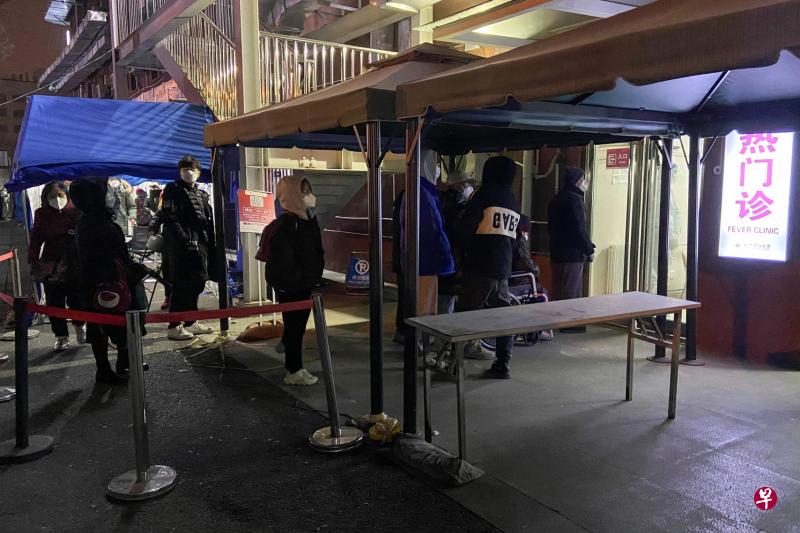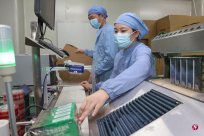
Chinese officials have repeatedly emphasized that patients with mild symptoms only need to recover at home, and only those with severe diseases must go to the hospital.However, the queuing people in front of the Beijing Chaoyang Hospital are mainly young people, and high -risk groups such as seniors are a minority.The pharmacies' fever and cold medicines were out of stock. Many patients went to the hospital for medicine.
On the unusually deserted Beijing street, the scene of outsiders from Beijing Chaoyang Hospital is particularly prominent; a dozen meters long windproof tent was arranged outside the hot nurse.Waiting for the clinic, a coughing sound echoed in the tent.
After the Chinese epidemic prevention and control was loosened, the number of infections soared, and the pressure faced by the medical system in the past week has increased sharply.When China Vice Premier Sun Chunlan went to Beijing to investigate and guide the prevention and control of the epidemic on Tuesday (December 13), he specified that he should transfer the focus of work from preventing and controlling infections to medical treatment. The medical system of various places was pushed to the forefront of epidemic prevention work in the new stage.
Passionate kidnappers increase by 16 times a week for the hospital for eight hours
In Beijing, where the epidemic is more serious, the hospital's hot ruling clinic is the first.The number of people in Beijing on December 11 reached 220,000, which was 16 times a week ago; the number of local 120 emergency hotline calls also surged, reaching 30,000 times on December 9, which is six times that of usual.
Many hospitals in Beijing have begun to appear on weekends, and some hospitals have been waiting for eight hours.According to the reporter's observation, the situation of queuing in Beijing Chaoyang Hospital was soothing on Tuesday afternoon, but the indoor waiting room of the popular kidney was still crowded with patients, and more than 20 patients lined up the windproof tents temporarily built outdoors.
Chinese officials have repeatedly emphasized that patients with general mildness only need to recover at home, and only those with severe high -risk people will go to the hospital for treatment.However, the queuing people in front of the Beijing Chaoyang Hospital are mainly young people, and high -risk groups such as seniors are a minority.In the case of general pharmacies' fever and cold drugs, many patients went to the hospital just to take medicine.
The 29 -year -old Hu Chen (pseudonym) told Lianhe Zaobao with a hoarse voice that he could not buy medicines everywhere for four days. He could only make some medicine between friends.Common together, just stand up. "
Hu Chen did not see a doctor during the fever, but because the company asked the sick leave to prove that he went to the hospital after he had a fever.
He said: "The company originally said that they could use antigen to test leave, but there were too many people who asked for leave, and temporarily requested that there must be a hospital sick leave certificate. I ca n’t stand it for an hour on Monday night.Come back at home the next afternoon. "
Many people with mild medical diseases in Beijing may continue to work
Shandong, which is more than 400 kilometers from Beijing, also has a tight medical resources. Chen Yuemei (a pseudonym, 39 years old), who is practicing medicine in the local area, said: "Many patients are actually mild, and they can not be used to the hospital at all ... I really need to see a doctor.There are only one of about a dozen people. "
Many medical staff in the hospital where Chen Yuemei is located has crown disease.The hospital currently requires infected medical staff to rest at home, but if there are too many colleagues who are sick, some colleagues with milder symptoms may be allowed to go to work.
Some Beijing medical staff told Reuters that 80 % of medical staff in some hospitals have been infected, and many infected people have to continue to work.A Sichuan medical staff revealed that his hospitals would receive 7 or eight hundred fever patients every day, and the hospital's antipyretic and cold medicines were out of stock.
Lu Xi, an assistant professor at the School of Public Policy of the National University of Singapore, analyzed that the tension of medical resources showed that China's epidemic prevention policy did not clearly open the roadmap and planning, mainly politically -oriented.Before the opening of the Chinese epidemic prevention, the lack of correct publicity of the public about the public, which led to two extreme phenomena of excessive relaxation and excessive nervousness; especially young people, they mistakenly thought that as long as they had no symptoms, they did not know that they had contagion.
No longer monitoring positive data, it is difficult to plan the open process
Although the number of infections in various parts of China has increased significantly, many areas have no longer required infected people to report to the community.December 14) Announced that the data of non -symptoms of crown disease will no longer be announced.
Lu Xi pointed out that the official no longer monitoring positive data will cause it to make the work of formulating a roadmap, and it is difficult to have accurate basic step -by -step planning process.
Many analysts believe that the peak of the epidemic in China's waves concentrated in the hot ruling clinic in large cities will be retreated after the supply of household medical supplies such as cold medicines and antigen kits;Essence
Zhao Litao, a senior researcher at the East Asian Research Institute of Singapore, studied and judged that China has strong production capacity, logistics capabilities and mobilization capabilities, and medical supplies will not become shortcomings;, And ensure the instant instant medical resources.
Lu Xi said that according to the current data, one -third to half of the Beijing population may be infected with crown diseases, and young and middle -aged groups with greater abortion should be quickly infected.After this wave of peaks passed, the situation of the elderly infected will gradually be reflected. Many of them have basic diseases, which will be a more urgent test for China's medical system.
The virus spreads the virus after the Spring Festival proliferation test to the weak area of medical resources
China has a long -term problem of uneven distribution of medical resources. The medical beds per 1,000 population are 677, and less than four of the severe medical beds per 100,000 population. These beds are highly concentrated in first- and second -tier cities.In comparison, the severe medical beds of the United States per 100,000 people are 34.7.
Chinese officials have specified the configuration of intensive resources and medical beds.Lu Xi predicts that by the peak of the population flow of the Spring Festival, the coronary virus may spread from large cities to third- and fourth -tier cities and small counties and rural areas. At that time, the weakest regions of China's medical resources will face a huge test.
Professor Paul Tambyah, president of the Asia -Pacific Clinical Microbiology and Infectious Diseases Society, pointed out how the biggest challenge to Chinese hospitals is to deal with non -crown medical services for usual backlogs.Each hospital must leave medical resources to a few patients who have to be hospitalized, and other patients who have delayed treatment due to the epidemic in the past two years.




